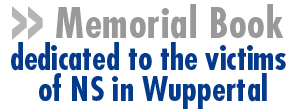List of Forced labourers
This list is based essentially on the inquiries conducted by Florian Speer, who analysed the registers of deaths of the civil registry office in Wuppertal. Since [besser genaue Jahreszahl angeben – so bleibt es aktuell] records can accessed in the International Tracing Service (ITS) Archive in Bad Arolsen, in particular comprehensive finding aids to which we were able to resort in our research.
With this Internet publication we hope that we can also reach the relatives of the forced labourers. So far we only know very little about the forced labourers killed in Wuppertal. Thus we turn in particular to the relatives and ask you to contact us. We are very much interested in biographical details and pictures of those who died as a result of slave labour in Wuppertal.
So, if you should find a relative on the list, please get in touch with us. A major problem concerning Soviet forced labourers is the often-incorrect transcription and spelling of the names. We’d be grateful if you could help us with the correct spelling.
Forced Labour in Wuppertal
About 20,000 to 25,000 slave labourers and prisoners of war were forced to labour in Wuppertal. At least 1,044 of them died, whom we know by name. The list of the dead includes 175 children of forced labourer, 139 of which hade been buried identified. A high mortality rate featured the so-called »baby nursery« of the company Kolb & Co. Here alone 26 toddlers died. The highest death rate had the transit camp Am Giebel, which was administered by the labour office. 44 children died here. Above all the children of Russian and Ukrainian mothers had little odds of survival: for 1944 Florian Speer has calculated a mortality rate of 24,5 % [for these children|, while the death rate for Polish children during the same time »merely« amounted to 3 %.
The most frequent causes of death for adult forced labourers given in the official death certificates were diseases like tuberculosis, dysentery, pneumonia and typhoid fever. Also a great number of forced labourers and prisoners of war were killed in air raids. The forced labourers were often denied access to normal air-raid shelter and had to seek refuge in the sewerage or in tunnels. In 1944 six forced labourers were killed in air raids, whereas in 1945 132 forced labourers and prisoners of war were killed in four months.
Repression and Extermination
In the case of misconduct or non-function for the company, (be it unpunctuality, absenteeism, insufficient output, illness, pregnancy or alleged sabotage) the forced labourers were threatened by massive repressive measures. Sexual relations between male Eastern workers with German women led to »special treatment«, i.e. execution of the accused or internment in a concentration camp. Some of the women unable work due to grave diseases were deported to so-called Sterbelager (camp for dying) or scheduled for »special treatment«, which meant in this case the commitment to institutions like Hadamar and Meseritz-Obrawalde, where thousands and thousands of forced labourers were killed with lethal injections. Pregnant women were forced to abort. Some »racially qualified« newborn children were after the nursing period taken away from their mothers and relocated and raised by »Aryan« parents or in institutions like the Lebensborn. »Racially inferior« children were located in so-called Ausländerkinder-Pflegestätten, where most of them died of hunger or diseases.
A complaint made by the company to the Gestapo or the labour office could lead to internment in a work education camp or concentration camp. During the last stage of war employer »complaints« ended in front of the Gestapo or regular police death squad.
